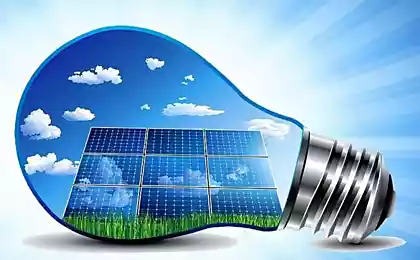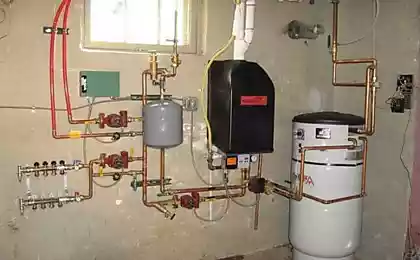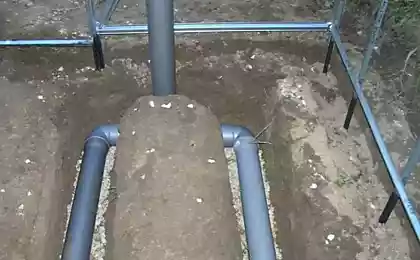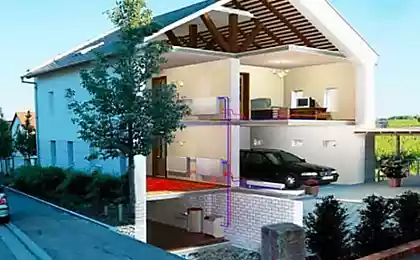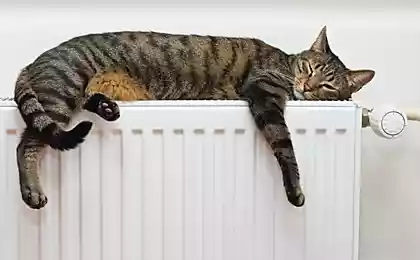619
Solar home heating collectors
Main units of the heating systemthe heat Source of a solar system serve as solar collectors, aimed at effective transfer of energy to the coolant of the infrared spectrum of solar radiation. Heat range of sunlight is 40-45% of the total radiation flux, and in concrete figures is 200-500 W/m2 depending on latitude, time of day and year.
In principle, to build a simple solar enough alone collectors. Their channels can circulate normal water used for household needs and heating. However, this approach is not sufficiently effective for several reasons, the first being the lack of replenishment of energy losses for a full day. Therefore, one of the most important elements of the solar heating system is the thermal battery — a container of water.
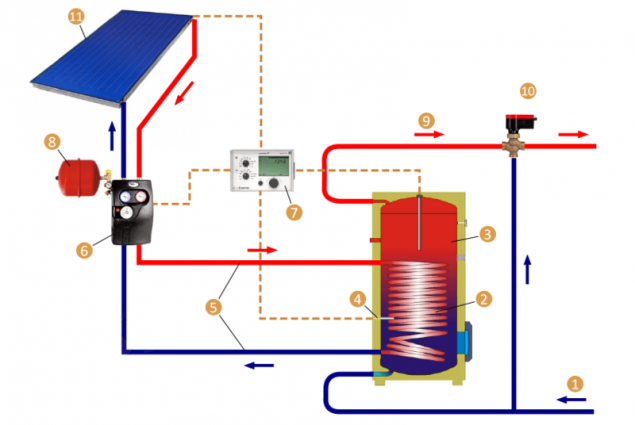
Diagram of home heating solar collectors: 1 — cold water supply; 2 — heat exchanger; 3 — accumulator; 4 — temperature sensor; 5 — coolant; 6 — pump station; 7 controller; 8 — a broad tank; 9 — hot water; 10 — three-way valve; 11 — solar collector
Also a limitation is the technical device of the solar collector. Its channels have a rather small cross section, causing the risk of clogging with solids. Also there is a high possibility of freezing of the coolant at night, the upper bound of the operating temperature range is 200-300 °C. the Collectors are designed for rapid continuous circulation of the coolant, which is supplied with a low temperature, heats up quickly in sunlight, and just as quickly gives up its heat to the battery.
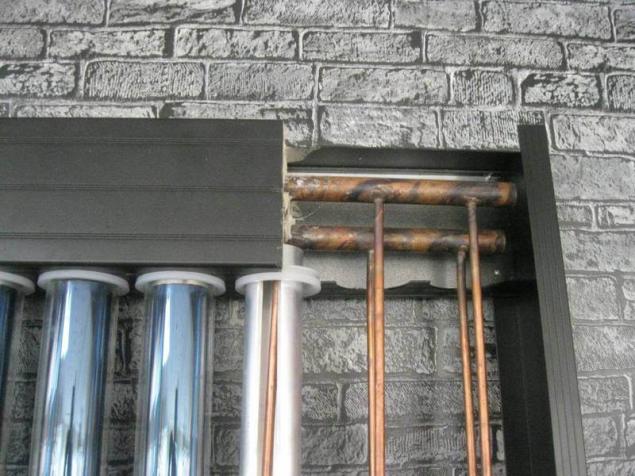
Vacuum tube U-tube solar collector
For these reasons, direct heating in heat pipes it is customary to use propylene glycol with special additives. Thus, the third required element of the heating solar systems — special coolant exchange circuit, which is often included in the structural composition of the storage tank, or may be part of the manifold.
Varieties and differences collectorsIf you do not go into the technical details of the device, the main difference between flat and vacuum collectors lies in the practicability of their use in different climatic zones. Flat-plate collectors are best used in southern latitudes with prevailing temperatures above freezing, vacuum — closer to the North.
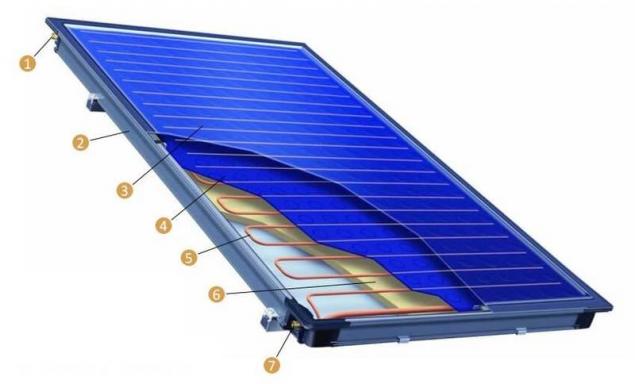
Design of flat solar collector: 1 — the output of the heat carrier; 2 — the frame header; 3 — structured Gladstone glass; 4 — absorber; 5 — copper tube; 6 — insulation; 7 — inlet of the coolant
The feasibility of some types of solar collectors due to several features:
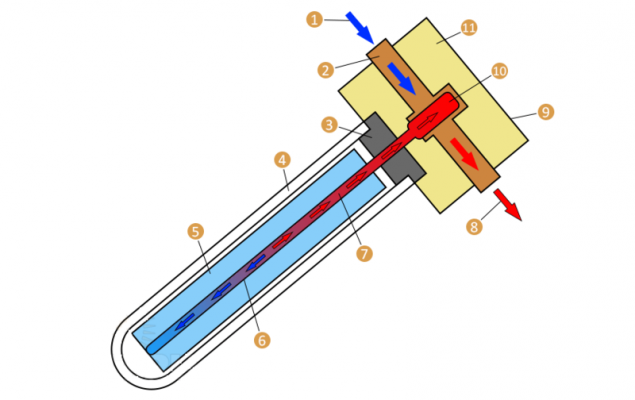
Design of the vacuum collector with indirect heat transfer: 1 — the entrance of the cooled heat carrier; 2 — heat exchanger (collector); 3 — a sealed tube; 4 — vacuum pipe; 5 aluminum plate (absorber); 6 — the heat pipe; 7 — working fluid; 8 — output of the heated coolant; 9 — body of the cooler; 10 — condenser of the heat pipe; 11 — isolation
One of the most important differences lies in the editing process. Flat-plate collectors require delivery to the roof assembled, while the vacuum can be collected locally. Also flat-plate collectors usually do not have a heat storage and exchange of the circuit.
Problems of solar energysolar Heating systems are not devoid of drawbacks, among them the chief of the variability of the energy source. At night the heating system, and when prolonged cloudy weather expect clear skies to heat the house — pleasure below average. If the battery has a sufficiently large volume is able to maintain the desired amount of heat at least until the morning, for several days of Autonomous operation in low light conditions it is possible to count only when a significant expansion of the solar farm. This, in turn, causes the reverse problem: when entering the maximum power (for example, in the spring, daylight) this solar system will require a more intensive heat removal or temporary shutdown of several absorbers with their shading.
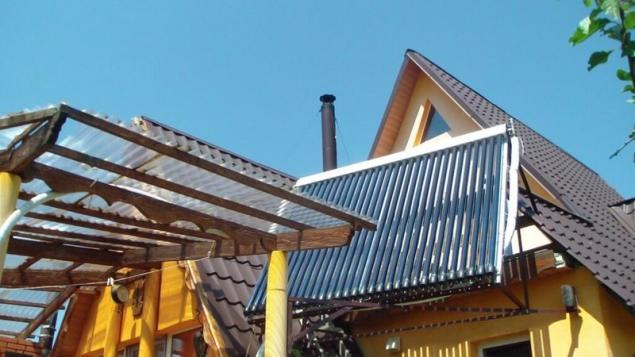
It is important to understand that the solar system is in the realities of the Russian climate can be used as the sole or primary source of heating. However, they can significantly reduce energy consumption during the heating season. Especially effective working of the hybrid collectors, in which the heaters combined with solar cells. If the cloud cover holds the majority of the IR radiation, the loss of the PV part of the spectrum is not significant.
Another disadvantage of solar collectors imprisoned in a forced circulation of the coolant in the system the collector battery. Some collectors are equipped with vacuum tank, designed for natural circulation and located above the absorber. Such installations are usually used in hot water systems with the abstraction of water pressure a cold water supply. But ways to work together such solar collectors to the heating system still exist.

Vacuum solar collector with tank
Integration into the heating system, There are two ways of combining solar collectors with arbitrarily complex heating system with liquid coolant. The main source of energy can be either gas or electricity — a significant difference there.
The first option, the total daily heating of the battery. The drive communicates with the boiler, together and consistently, at a high enough temperature, the latter comes into operation and heats the liquid. A properly designed system of this kind can work effectively even without forced circulation.

1 — the heating circuit; 2 — heating liquid; 3 — temperature sensor; 4 — pumping station; 5 — controller; 6 — pump; 7 — a broad tank; 8 — sanitary water; 9 — cold water; 10 — DHW; 11 — solar collector; 12 — heating boiler
The second type of combination involves the use of the heat accumulator with two circuits. After one is made up of heat from the manifold, through the second heating of the coolant in the system, the water from the battery serves as a source of domestic hot water. Since the circuits are isolated from each other, in the heating system and the heat transfer loop from the solar collector can be used over a thermal fluid or antifreeze. Main drawback is the energy dependence of the system, because in both circulation circuits is carried out forcibly.

1 — cold water supply; 2 — temperature sensor; 3 — heat exchanger of the solar collector; 4 — heat exchanger of the boiler; 5 — coolant reservoir; 6 — pump station; 7 controller; 8 — a broad tank; 9 — circulating pump; 10 — hot water outlet; 11 — boiler; 12 — solar collector
Power calculation and installation stagesthe Transition to solar energy does not tolerate haste and superficial approach. Often the conclusions about the feasibility of installing a solar system can only be done after a few years of observations and calculations.
Unfortunately, relying on inalazione card does not make much sense, since local weather conditions can greatly distort the average figures. So the first thing to do is to report on the intensity of solar radiation at the installation location of the collectors. For measurements use pyranometer, within 5 thousand rubles, you can buy a budget device with a sufficient set of functions.

Pyranometer
Measurements should be taken at different times of the day with a periodicity of about a week throughout the year. In the process measurements need to take into account the angle and orientation of collectors. The data obtained in the result cross-checked with the statistics of meteorologist on the percentage of cloudy days per year.
To ensure high efficiency of the solar thermal system should be considered the most negative scenario, that is, to take for a reference point, the longest period with the lowest illumination. Ideally, you can make an adjustment for the likelihood of more adverse weather conditions, using weather statistics for the last 15-20 years. The obtained data on incoming solar energy will help to establish the necessary total area of the absorption field and to determine the number of collectors that need to be purchased.
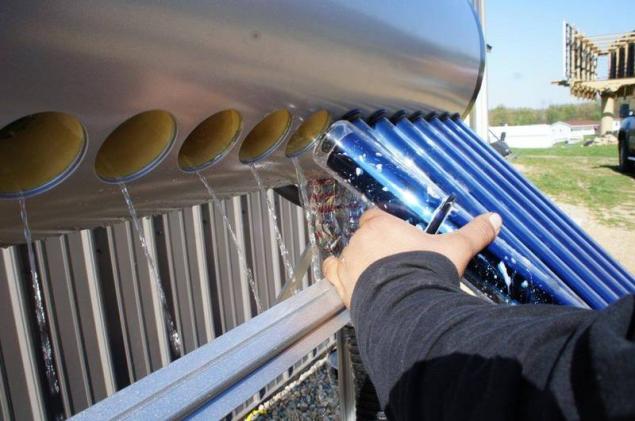
As mentioned, collectors are very rarely used as a primary heat source, they usually play a supporting role. But the share can be calculated, it is indicated as a percentage of the total power grid of the home or its heat losses. Having obtained the required number of kilowatts, it is multiplied by the optical efficiency of the absorbers, adding a few indexes — amendment on orientation, tilt, temperature, and supply reliability.
For a "clean" value of the generated power is selected:

For self-installation and service must draw up a draft system to allocate space for placement of ancillary devices and to fix a solar collector on the South (for the Northern hemisphere) slope of the roof taking into account the recommendations of the supplier of equipment on the part of the wind loads. Do not forget that acquiring a full set of equipment from one distributor, you get the opportunity to be if not the project heating solar system, then at least a good list of compatible hardware and components.

Whether the heat pump isOne of the major drawbacks of solar heating systems is the high cost. While the production technology of flat plate collectors well mastered, the vacuum absorbers remain expensive, but in certain weather conditions, successfully manage to exploit. But there is another alternative — collectors air-type.

Solar collector air type
In view of the simple device they cost less, plus you have the option to work offline. The efficiency of the air collectors increases with the installation of the blower, powered by built-in solar panel. Through accelerated, but proportional to the heating of the cooling channels of the reverse heat loss through the manifold is minimized. The power limit it is possible to provide a fan speed control or simple overlap duct — heat stroke air reservoirs are not afraid, moreover, easy to customize natural recycling.
The lack of air systems in a small degree of heating of the coolant. The heat capacity of air is less, plus almost always the absorber is heated without focus. To enable integration into the heating system (most often necessary because of the inability to lay ventkanal in a heated room) heat pump or split system is really needed.

But air source heat pumps can be applied to increase the efficiency of air-conditioning. With them, the circulation rate cannot increase to values that are not acceptable in domestic ventilation systems, which gives a 2-3 fold increase in production due to the high temperature difference. At night time the collector will also have a small share of generation at an operating temperature range.
Used as a coolant air can be drained or replaced by carbon dioxide or other more heat-intensive gas. However, heat pumps with water loop primary use does not make sense: they were originally designed to work with high temperature difference and therefore power gain is not enough to justify the setup cost.
The cost of solar heating installationsFor the use of clean energy generally have to pay quite expensive, at least for today. In fairness, there are positive news: over the past five years the cost of manufacturing flat-plate collectors fell in 2-2,5 times, similar can soon be expected from devices with vacuum absorbers.
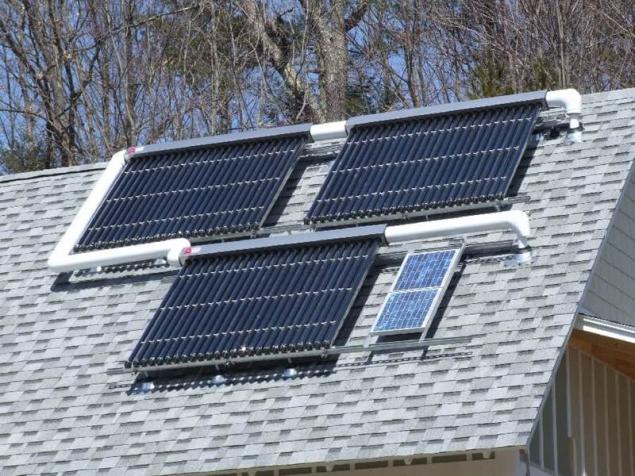
The cost of flat and vacuum collectors is determined by the output value of solar radiation in ideal lighting conditions, that is, power density. On average 1 kW of solar collectors flat type will have to pay about $350-500, and complete the installation with the external device is around $800-1000. The cost of the vacuum solar collectors varies in a higher range, from $600 to $1000-1200 for a set depending on quality of performance, material of tubes, insulation of the heat exchanger and other features.
For capacitive collectors, there is a norm, measured in liters of water heated to the highest temperature possible. To calculate the amount of electricity generated can be either total area of the absorber, or expressed through the specific heat of water. Depending on the complexity of the system cost varies widely, the price is one of the examples from mid-market up to $1500 for 300 liters (4-5 residents) with a temperature difference of about 50 °C, which is equivalent to 2.5 kW power density. published
P. S. And remember, only by changing their consumption — together we change the world! ©
Source: www.rmnt.ru/story/heating/1304414.htm
In principle, to build a simple solar enough alone collectors. Their channels can circulate normal water used for household needs and heating. However, this approach is not sufficiently effective for several reasons, the first being the lack of replenishment of energy losses for a full day. Therefore, one of the most important elements of the solar heating system is the thermal battery — a container of water.

Diagram of home heating solar collectors: 1 — cold water supply; 2 — heat exchanger; 3 — accumulator; 4 — temperature sensor; 5 — coolant; 6 — pump station; 7 controller; 8 — a broad tank; 9 — hot water; 10 — three-way valve; 11 — solar collector
Also a limitation is the technical device of the solar collector. Its channels have a rather small cross section, causing the risk of clogging with solids. Also there is a high possibility of freezing of the coolant at night, the upper bound of the operating temperature range is 200-300 °C. the Collectors are designed for rapid continuous circulation of the coolant, which is supplied with a low temperature, heats up quickly in sunlight, and just as quickly gives up its heat to the battery.

Vacuum tube U-tube solar collector
For these reasons, direct heating in heat pipes it is customary to use propylene glycol with special additives. Thus, the third required element of the heating solar systems — special coolant exchange circuit, which is often included in the structural composition of the storage tank, or may be part of the manifold.
Varieties and differences collectorsIf you do not go into the technical details of the device, the main difference between flat and vacuum collectors lies in the practicability of their use in different climatic zones. Flat-plate collectors are best used in southern latitudes with prevailing temperatures above freezing, vacuum — closer to the North.

Design of flat solar collector: 1 — the output of the heat carrier; 2 — the frame header; 3 — structured Gladstone glass; 4 — absorber; 5 — copper tube; 6 — insulation; 7 — inlet of the coolant
The feasibility of some types of solar collectors due to several features:
- the inability of a vacuum manifold independently to be cleared of snow;
- high heat flat solar collectors, increasing with temperature difference;
- low resistance flat-plate collectors to wind loads;
- the high cost of the project on vacuum solar collectors;
- the low temperature range the effective use of flat collectors.

Design of the vacuum collector with indirect heat transfer: 1 — the entrance of the cooled heat carrier; 2 — heat exchanger (collector); 3 — a sealed tube; 4 — vacuum pipe; 5 aluminum plate (absorber); 6 — the heat pipe; 7 — working fluid; 8 — output of the heated coolant; 9 — body of the cooler; 10 — condenser of the heat pipe; 11 — isolation
One of the most important differences lies in the editing process. Flat-plate collectors require delivery to the roof assembled, while the vacuum can be collected locally. Also flat-plate collectors usually do not have a heat storage and exchange of the circuit.
Problems of solar energysolar Heating systems are not devoid of drawbacks, among them the chief of the variability of the energy source. At night the heating system, and when prolonged cloudy weather expect clear skies to heat the house — pleasure below average. If the battery has a sufficiently large volume is able to maintain the desired amount of heat at least until the morning, for several days of Autonomous operation in low light conditions it is possible to count only when a significant expansion of the solar farm. This, in turn, causes the reverse problem: when entering the maximum power (for example, in the spring, daylight) this solar system will require a more intensive heat removal or temporary shutdown of several absorbers with their shading.

It is important to understand that the solar system is in the realities of the Russian climate can be used as the sole or primary source of heating. However, they can significantly reduce energy consumption during the heating season. Especially effective working of the hybrid collectors, in which the heaters combined with solar cells. If the cloud cover holds the majority of the IR radiation, the loss of the PV part of the spectrum is not significant.
Another disadvantage of solar collectors imprisoned in a forced circulation of the coolant in the system the collector battery. Some collectors are equipped with vacuum tank, designed for natural circulation and located above the absorber. Such installations are usually used in hot water systems with the abstraction of water pressure a cold water supply. But ways to work together such solar collectors to the heating system still exist.

Vacuum solar collector with tank
Integration into the heating system, There are two ways of combining solar collectors with arbitrarily complex heating system with liquid coolant. The main source of energy can be either gas or electricity — a significant difference there.
The first option, the total daily heating of the battery. The drive communicates with the boiler, together and consistently, at a high enough temperature, the latter comes into operation and heats the liquid. A properly designed system of this kind can work effectively even without forced circulation.

1 — the heating circuit; 2 — heating liquid; 3 — temperature sensor; 4 — pumping station; 5 — controller; 6 — pump; 7 — a broad tank; 8 — sanitary water; 9 — cold water; 10 — DHW; 11 — solar collector; 12 — heating boiler
The second type of combination involves the use of the heat accumulator with two circuits. After one is made up of heat from the manifold, through the second heating of the coolant in the system, the water from the battery serves as a source of domestic hot water. Since the circuits are isolated from each other, in the heating system and the heat transfer loop from the solar collector can be used over a thermal fluid or antifreeze. Main drawback is the energy dependence of the system, because in both circulation circuits is carried out forcibly.

1 — cold water supply; 2 — temperature sensor; 3 — heat exchanger of the solar collector; 4 — heat exchanger of the boiler; 5 — coolant reservoir; 6 — pump station; 7 controller; 8 — a broad tank; 9 — circulating pump; 10 — hot water outlet; 11 — boiler; 12 — solar collector
Power calculation and installation stagesthe Transition to solar energy does not tolerate haste and superficial approach. Often the conclusions about the feasibility of installing a solar system can only be done after a few years of observations and calculations.
Unfortunately, relying on inalazione card does not make much sense, since local weather conditions can greatly distort the average figures. So the first thing to do is to report on the intensity of solar radiation at the installation location of the collectors. For measurements use pyranometer, within 5 thousand rubles, you can buy a budget device with a sufficient set of functions.

Pyranometer
Measurements should be taken at different times of the day with a periodicity of about a week throughout the year. In the process measurements need to take into account the angle and orientation of collectors. The data obtained in the result cross-checked with the statistics of meteorologist on the percentage of cloudy days per year.
To ensure high efficiency of the solar thermal system should be considered the most negative scenario, that is, to take for a reference point, the longest period with the lowest illumination. Ideally, you can make an adjustment for the likelihood of more adverse weather conditions, using weather statistics for the last 15-20 years. The obtained data on incoming solar energy will help to establish the necessary total area of the absorption field and to determine the number of collectors that need to be purchased.

As mentioned, collectors are very rarely used as a primary heat source, they usually play a supporting role. But the share can be calculated, it is indicated as a percentage of the total power grid of the home or its heat losses. Having obtained the required number of kilowatts, it is multiplied by the optical efficiency of the absorbers, adding a few indexes — amendment on orientation, tilt, temperature, and supply reliability.
For a "clean" value of the generated power is selected:
- the desired number of headers of a particular model and one backup solar collectors for 10-15 in work;
- the pipework manufacturer's recommended capacity and temperature resistance;
- circulation group, valves, other auxiliary devices;
- the volume and placement of the battery tank. In systems with a daily drive or power thermal selection of more than 20 kW it makes sense to build insulated concrete tanks with capacity of 15-20 m3.

For self-installation and service must draw up a draft system to allocate space for placement of ancillary devices and to fix a solar collector on the South (for the Northern hemisphere) slope of the roof taking into account the recommendations of the supplier of equipment on the part of the wind loads. Do not forget that acquiring a full set of equipment from one distributor, you get the opportunity to be if not the project heating solar system, then at least a good list of compatible hardware and components.

Whether the heat pump isOne of the major drawbacks of solar heating systems is the high cost. While the production technology of flat plate collectors well mastered, the vacuum absorbers remain expensive, but in certain weather conditions, successfully manage to exploit. But there is another alternative — collectors air-type.

Solar collector air type
In view of the simple device they cost less, plus you have the option to work offline. The efficiency of the air collectors increases with the installation of the blower, powered by built-in solar panel. Through accelerated, but proportional to the heating of the cooling channels of the reverse heat loss through the manifold is minimized. The power limit it is possible to provide a fan speed control or simple overlap duct — heat stroke air reservoirs are not afraid, moreover, easy to customize natural recycling.
The lack of air systems in a small degree of heating of the coolant. The heat capacity of air is less, plus almost always the absorber is heated without focus. To enable integration into the heating system (most often necessary because of the inability to lay ventkanal in a heated room) heat pump or split system is really needed.

But air source heat pumps can be applied to increase the efficiency of air-conditioning. With them, the circulation rate cannot increase to values that are not acceptable in domestic ventilation systems, which gives a 2-3 fold increase in production due to the high temperature difference. At night time the collector will also have a small share of generation at an operating temperature range.
Used as a coolant air can be drained or replaced by carbon dioxide or other more heat-intensive gas. However, heat pumps with water loop primary use does not make sense: they were originally designed to work with high temperature difference and therefore power gain is not enough to justify the setup cost.
The cost of solar heating installationsFor the use of clean energy generally have to pay quite expensive, at least for today. In fairness, there are positive news: over the past five years the cost of manufacturing flat-plate collectors fell in 2-2,5 times, similar can soon be expected from devices with vacuum absorbers.

The cost of flat and vacuum collectors is determined by the output value of solar radiation in ideal lighting conditions, that is, power density. On average 1 kW of solar collectors flat type will have to pay about $350-500, and complete the installation with the external device is around $800-1000. The cost of the vacuum solar collectors varies in a higher range, from $600 to $1000-1200 for a set depending on quality of performance, material of tubes, insulation of the heat exchanger and other features.
For capacitive collectors, there is a norm, measured in liters of water heated to the highest temperature possible. To calculate the amount of electricity generated can be either total area of the absorber, or expressed through the specific heat of water. Depending on the complexity of the system cost varies widely, the price is one of the examples from mid-market up to $1500 for 300 liters (4-5 residents) with a temperature difference of about 50 °C, which is equivalent to 2.5 kW power density. published
P. S. And remember, only by changing their consumption — together we change the world! ©
Source: www.rmnt.ru/story/heating/1304414.htm
Citroen has released passenger electrovan
With the new material, the smartphone can be recharged from the pan

